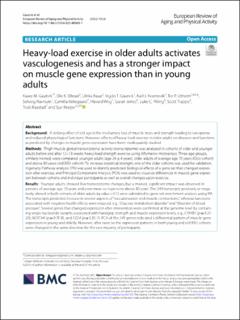Heavy-load exercise in older adults activates vasculogenesis and has a stronger impact on muscle gene expression than in young adults
Olstad, Ole Kristoffer; Raue, Ulrika; Gautvik, Vigdis Teig; Kvernevik, Karl Johnny; Utheim, Tor Paaske; Ravnum, Solveig; Kirkegaard, Camilla; Wiig, Håvard; Jones, Garan; Pilling, Luke C.; Trappe, Scott; Raastad, Truls; Reppe, Sjur; Gautvik, Kaare M.
Peer reviewed, Journal article
Published version
Permanent lenke
https://hdl.handle.net/11250/3035262Utgivelsesdato
2022Metadata
Vis full innførselSamlinger
- Artikler / Articles [2096]
- Publikasjoner fra Cristin [1084]
Originalversjon
European Review of Aging and Physical Activity. 2022, 19(2022), Artikkel 23. 10.1186/s11556-022-00304-1Sammendrag
Background: A striking effect of old age is the involuntary loss of muscle mass and strength leading to sarcopenia and reduced physiological functions. However, effects of heavy-load exercise in older adults on diseases and functions as predicted by changes in muscle gene expression have been inadequately studied.
Methods: Thigh muscle global transcriptional activity (transcriptome) was analyzed in cohorts of older and younger adults before and after 12–13 weeks heavy-load strength exercise using Affymetrix microarrays. Three age groups, similarly trained, were compared: younger adults (age 24 ± 4 years), older adults of average age 70 years (Oslo cohort) and above 80 years (old BSU cohort). To increase statistical strength, one of the older cohorts was used for validation. Ingenuity Pathway analysis (IPA) was used to identify predicted biological effects of a gene set that changed expression after exercise, and Principal Component Analysis (PCA) was used to visualize differences in muscle gene expressen between cohorts and individual participants as well as overall changes upon exercise.
Results: Younger adults, showed few transcriptome changes, but a marked, significant impact was observed in persons of average age 70 years and even more so in persons above 80 years. The 249 transcripts positively or negatively altered in both cohorts of older adults (q-value < 0.1) were submitted to gene set enrichment analysis using IPA. The transcripts predicted increase in several aspects of “vascularization and muscle contractions”, whereas functions associated with negative health effects were reduced, e.g., “Glucose metabolism disorder” and “Disorder of blood pressure”. Several genes that changed expression after intervention were confirmed at the genome level by containing single nucleotide variants associated with handgrip strength and muscle expression levels, e.g., CYP4B1 (p = 9.2E-20), NOTCH4 (p = 9.7E-8), and FZD4 (p = 5.3E-7). PCA of the 249 genes indicated a differential pattern of muscle gene expression in young and elderly. However, after exercise the expression patterns in both young and old BSU cohorts were changed in the same direction for the vast majority of participants.
Conclusions: The positive impact of heavy-load strength training on the transcriptome increased markedly with age. The identified molecular changes translate to improved vascularization and muscular strength, suggesting highly beneficial health effects for older adults.
Beskrivelse
This article is licensed under a Creative Commons Attribution 4.0 International License, which permits use, sharing, adaptation, distribution and reproduction in any medium or format, as long as you give appropriate credit to the original author(s) and the source, provide a link to the Creative Commons licence, and indicate if changes were made. The images or other third party material in this article are included in the article's Creative Commons licence, unless indicated otherwise in a credit line to the material. If material is not included in the article's Creative Commons licence and your intended use is not permitted by statutory regulation or exceeds the permitted use, you will need to obtain permission directly from the copyright holder.
